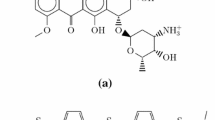Abstract
An approach is developed that allows estimation of excited quadrupole molecule parameters responsible for changes in vibration frequencies in states with symmetry breaking by charge transfer from time-resolved IR spectra. The approach is tested on a molecule like A-π-D-π-A composed of an electron-accepting group A coupled with electron-donating group D by means of π-conjugated bonds, a D pyrrolopyrrole core, and two cyanophenyl acceptors. The expression derived for the IR spectrum of a molecule with symmetry breaking is shown to perfectly describe experimental data. The numerical values of the parameters of asymmetry in a series of solvents with different polarities and the solvent-independent parameters of the molecule itself are determined.





Similar content being viewed by others
REFERENCES
C. le Droumaguet, O. Mongin, M. H. V. Werts, and M. Blanchard-Desce, Chem. Commun., 2802 (2005). https://doi.org/10.1039/B502585K
N. Mataga, H. Yao, T. Okado, and W. Retting, J. Phys. Chem. 93, 3383 (1989). https://doi.org/10.1021/j100346a004
J. J. Piet, W. Schuddeboom, B. R. Wegewijs, et al., J. Am. Chem. Soc. 123, 5337 (2001). https://doi.org/10.1021/ja004341o
W. Beljonne, E. Wenseleers, Z. Zojer, et al., Adv. Funct. Mater. 12, 631 (2002). https://doi.org/10.1002/1616-3028(20020916)12:9<631::AID-ADFM631>3.0.CO;2-W
A. Kovalenko, J. L. P. Lustres, N. P. Ernsting, and W. Rettig, J. Phys. Chem. A 107, 10228 (2003). https://doi.org/10.1021/jp026802t
D. Lewis, P. Daublain, L. Zhang, et al., J. Phys. Chem. B 112, 3838 (2008). https://doi.org/10.1021/jp710718p
S. Bhosale, A. L. Sisson, P. Talukdar, et al., Science (Washington, DC, U. S.) 313, 84 (2006). https://doi.org/10.1126/science.1126524
N. Banerji, A. Furstenberg, S. Bhosale, et al., J. Phys. Chem. B 112, 8912 (2008). https://doi.org/10.1021/jp801276p
N. Banerji, G. Duvanel, A. Perez-Velasco, et al., J. Phys. Chem. A 113, 8202 (2009). https://doi.org/10.1021/jp903572r
J. M. Giaimo, A. V. Gusev, and M. R. Wasielewski, J. Am. Chem. Soc. 124, 8530 (2002). https://doi.org/10.1021/ja026422l
M. W. Holman, P. Yan, D. M. Adams, et al., J. Phys. Chem. A 109, 8548 (2005). https://doi.org/10.1021/jp0502050
H. Hu, O. V. Przhonska, F. Terenziani, et al., Phys. Chem. Chem. Phys. 15, 7666 (2013). https://doi.org/10.1039/C3CP50811K
C. Sissa, F. Delchiaro, F. D. Maiolo, et al., J. Chem. Phys. 141, 164317 (2014). https://doi.org/10.1063/1.4898710
A. Rebane, M. Drobizhev, N. S. Makarov, et al., J. Phys. Chem. A 118, 3749 (2014). https://doi.org/10.1021/jp5009658
C. Trinh, K. Kirlikovali, S. Das, et al., J. Phys. Chem. C 118, 21834 (2014). https://doi.org/10.1021/jp506855t
B. Carlotti, E. Benassi, A. Spalletti, et al., Phys. Chem. Chem. Phys. 16, 13984 (2014). https://doi.org/10.1039/C4CP00631C
B. Carlotti, E. Benassi, C. G. Fortuna, et al., Chem. Phys. Chem. 17, 136 (2016). https://doi.org/10.1002/cphc.201500784
B. Dereka, A. Rosspeintner, Z. Li, et al., J. Am. Chem. Soc. 138, 4643 (2016). https://doi.org/10.1021/jacs.6b01362
B. Dereka, A. Rosspeintner, M. Krzeszewski, et al., Angew. Chem., Int. Ed. 55, 15624 (2016). https://doi.org/10.1002/anie.201608567
B. Dereka, A. Rosspeintner, R. Stezycki, et al., J. Phys. Chem. Lett. 8, 6029 (2017). https://doi.org/10.1021/acs.jpclett.7b02944
B. Dereka and E. Vauthey, J. Phys. Chem. Lett. 8, 3927 (2017). https://doi.org/10.1021/acs.jpclett.7b01821
F. Terenziani, A. Painelli, C. Katan, et al., J. Am. Chem. Soc. 128, 15742 (2006). https://doi.org/10.1021/ja064521j
A. I. Ivanov, B. Dereka, and E. Vauthey, J. Chem. Phys. 146, 164306 (2017). https://doi.org/10.1063/1.4982067
A. I. Ivanov and V. G. Tkachev, J. Chem. Phys. 151, 124309 (2019). https://doi.org/10.1063/1.5116015
A. I. Ivanov, J. Phys. Chem. C 122, 29165 (2018). https://doi.org/10.1021/acs.jpcc.8b10985
F. Colobert and J. Wencel-Delord, C-H Activation for Asymmetric Synthesis (Wiley-VCH, Weinheim, 2019).
H. Pellissier, Asymmetric Metal Catalysis in Enantioselective Domino Reactions (Wiley-VCH, Weinheim, 2019).
L. Onsager, J. Am. Chem. Soc. 58, 1486 (1936). https://doi.org/10.1021/ja01299a050
B. Dereka, J. Helbing, and E. Vauthey, Angew. Chem., Int. Ed. 57, 17014 (2018). https://doi.org/10.1002/anie.201808324
ACKNOWLEDGMENTS
The authors are grateful to Professor Eric Vauthey of the University of Geneva for providing the experimental data presented in Figs. 2 and 3.
Funding
This work was supported by the Russian Foundation for Basic Research and the Administration of the Volgograd oblast as part of scientific project no. 19-43-340003r_a.
Author information
Authors and Affiliations
Corresponding author
Additional information
Translated by E. Glushachenkova
Rights and permissions
About this article
Cite this article
Nazarov, A.E., Ivanov, A.I. Modeling the IR Spectra of Excited Quadrupole Molecules with Broken Symmetry in Polar Solvents. Russ. J. Phys. Chem. 94, 1607–1615 (2020). https://doi.org/10.1134/S003602442008021X
Received:
Revised:
Accepted:
Published:
Issue Date:
DOI: https://doi.org/10.1134/S003602442008021X




